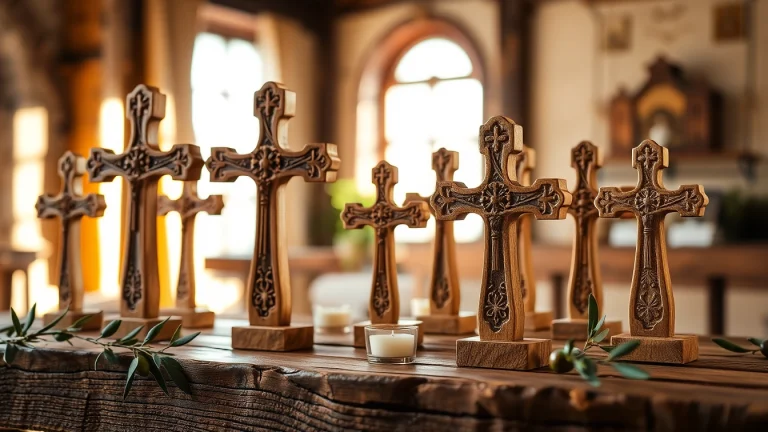
Understanding the Heritage and Symbolism of Jerusalem Crosses
The Rich History of Jerusalem Crosses
The Jerusalem crosses have a profound and multifaceted history that intertwines with the rich tapestry of Christian heritage. As symbols of faith and identity, they represent a deep-rooted connection to the Holy City of Jerusalem and its significant religious connotations. The Jerusalem Cross, often adorned with layer upon layer of meaning and history, is much more than a simple Christian emblem; it is a reflection of centuries of religious evolution and cultural exchange.
Origins and Development through the Centuries
The origins of the Jerusalem Cross can be traced back to the early Christian period, sometime around the 11th century. This heraldic cross, also known as the “Crusader’s Cross” or “five-fold Cross,” features a large central cross with four smaller Greek crosses at its corners. It is believed to symbolize the spread of the Gospel to the four corners of the earth, echoing the missionary call of Jesus to his disciples.
The cross’s inception is closely tied to the historical context of the Crusades. After the First Crusade in 1099, the symbol gained traction among the Crusaders as they sought to establish a Christian kingdom in the Holy Land. The Kingdom of Jerusalem embraced the cross, which eventually became emblematic of their mission and identity, serving both spiritual and political purposes. Its association with the Crusaders added a layer of complexity to its symbolism, as the cross became intertwined with notions of conquest, faith, and territorial claim.
The Role of Jerusalem Crosses in Christian Art
The artistic representation of the Jerusalem Cross evolved throughout the centuries. Initially, it was primarily a religious symbol, utilized in churches, manuscripts, and other sacred artifacts. Artists often infused their interpretations with local cultural elements, which contributed to a diverse range of representations. For instance, in Byzantine art, the cross was sometimes embellished with intricate mosaics or gold leaf, reflecting the opulence associated with the divine.
Throughout the Renaissance, the Jerusalem Cross found its way into paintings and sculptures, where it took on new meanings as artists began to emphasize human emotions and the relationship between God and humanity. The cross served as a focal point in various biblical narratives, dramatically portrayed in works by artists such as El Greco and Caravaggio. This evolution reflects how the symbolism of the Jerusalem Cross transcended mere iconography to embody broader themes of faith, sacrifice, and redemption.
Modern Interpretations and Variations
In contemporary times, the Jerusalem Cross continues to inspire artists and craftsmen. It has seen a resurgence in popularity with the rise of spirituality-focused art and design. Various interpretations have emerged—some portray it in minimalist styles, while others embellish it with ornate details that pay homage to its historical roots. Jewelry designers often incorporate the cross into pendants and earrings, allowing individuals to carry a piece of Jerusalem’s spiritual heritage with them.
Moreover, the Jerusalem Cross has entered popular culture as a symbol of peace and reconciliation in a region often associated with conflict. By embracing its powerful yet complex symbolism, many contemporary creators aim to foster dialogue and unity among diverse cultures and faiths. Thus, the cross stands not only as a bearer of the Christian message but also as an emblem of hope for coexistence in the modern world.
Symbolism Behind the Jerusalem Cross
The Jerusalem Cross is laden with meaning that speaks to its origins and the faith it represents. Understanding its symbolism allows us to appreciate its significance within Christianity and beyond it.
Meaning of the Five Crosses
Central to the design of the Jerusalem Cross is its five crosses: one large central cross flanked by four smaller crosses. This configuration conveys a dual meaning. The larger cross signifies Christ’s central role in salvation, while the smaller crosses are often interpreted as representing the Four Evangelists: Matthew, Mark, Luke, and John. Together, they embody the mission of spreading Christ’s teachings throughout the world.
Additionally, the smaller crosses are also thought to represent the four cardinal directions—north, south, east, and west—symbolizing the global reach of the Christian faith as it spreads from Jerusalem. This interpretation resonates strongly in the context of the Great Commission, where Jesus instructed His disciples to preach to all nations.
Jerusalem Cross in Different Christian Traditions
The significance of the Jerusalem Cross transcends denominational boundaries within Christianity. However, its most prominent use can be found in Catholicism and Orthodox Christianity. For instance, the Latin Patriarch of Jerusalem adopted the cross as a symbol of authority within the Latin Church, allowing it to become an emblem of the Catholic Church in the Holy Land. Similarly, it has been embraced by various Eastern Orthodox congregations, demonstrating its acceptance across diverse Christian traditions.
In each tradition, the cross signifies different aspects of the faith. For Catholics, it may emphasize the importance of pilgrimage to Jerusalem and the sacrificial nature of Christ’s death. Orthodox Christians might view it as a reminder of the resurrection and the hope of eternal life, thus enhancing its spiritual significance.
Cultural Significance in Contemporary Society
Today, the Jerusalem Cross carries considerable cultural weight beyond its religious connotations. It is often viewed as a symbol of unity among Christians worldwide, a representation of shared faith and mutual respect. In a world fragmented by religious differences, the crusading effort towards interfaith dialogue and peace efforts has often placed the cross at the forefront of these initiatives.
Moreover, the Jerusalem Cross has found its way into modern identity politics as various groups seek to reclaim or reinterpret its meanings. This cross can be a point of contention or celebration depending on the context in which it is presented, demonstrating how symbols evolve with the cultures that adopt them. The cross, therefore, represents not only a religious identity but also a broader message of hope and peace among humankind.
Craftsmanship of Jerusalem Crosses
The craftsmanship involved in creating Jerusalem Crosses reflects a long tradition of artistry and religious devotion. Every aspect of these crosses, from design to materials, plays an essential role in their creation, ensuring that their beauty resonates with believers and collectors alike.
Materials Used in Creation
Traditionally, Jerusalem Crosses are crafted from a variety of materials, each contributing to the cross’s both aesthetic appeal and spiritual significance. The most common material used for these crosses is olive wood, famous for its connection to the Holy Land. Olive wood, sourced from the ancient olive trees of Bethlehem, is valued for its durability and uniqueness, with each piece telling its own story through distinctive grain patterns and shades.
In addition to olive wood, artisans also work with metals such as gold, silver, and bronze. These materials are often used in jewelry production—adding a sense of opulence and beauty to the classic form of the Jerusalem Cross. Gemstones like crystal and colored glass may embellish these pieces, enhancing the overall artistic presentation.
Techniques and Artistry Involved
The techniques employed in crafting Jerusalem Crosses vary, reflecting regional styles, cultural influences, and individual artisans’ preferences. Hand-carving is one of the hallmark methods used to create wooden crosses, requiring significant skill and attention to detail. This artisan method allows for unique and intricate designs that can reflect personal narratives or religious significance.
For metal crosses, techniques such as engraving, casting, and inlay work are popularly utilized. Each approach offers different aesthetic qualities and can dramatically influence the final appearance of the cross. Artisans often employ combinations of these techniques to create substantial narratives within each piece, merging religious symbols with local artistry.
Tips for Choosing Authentic Jerusalem Crosses
When selecting Jerusalem Crosses, authenticity is paramount, particularly for those seeking genuine representations of their faith or cultural heritage. Here are several tips to consider:
- Look for Authentic Sources: Purchase from reputable dealers or artisans who specialize in religious artifacts from the Holy Land.
- Check Documentation: Authentic pieces often come with certificates of authenticity, proving their origin and craftsmanship.
- Inspect Materials: Genuine Jerusalem Crosses will be made from quality materials like olive wood or precious metals. Be wary of synthetic materials or mass-produced replicas that lack artistic merit.
- Understand Cultural Context: Research the symbolism and significance behind the design to ensure that it resonates with your own beliefs and values.
- Seek Unique Designs: Craftsmen often personalize their crosses, reflecting individual artistic interpretations. Look for pieces that stand out as unique rather than homogeneous mass-produced items.
Jerusalem Crosses in Popular Culture
The Jerusalem Cross has transcended its religious boundaries and has been woven into the fabric of popular culture. Its presence can be seen in literature, media, fashion, and various aspects of modern life.
Representations in Literature and Media
In literature, the symbolism of the Jerusalem Cross has been explored in various ways, often representing faith and the journey of self-discovery. Authors have utilized its image to evoke themes of sacrifice, redemption, and the struggle between good and evil. The cross is sometimes portrayed as a guiding light or a powerful reminder of one’s spiritual obligations in narratives that tackle moral dilemmas.
Media representations also explore the Jerusalem Cross’s storied history. Documentaries and films which address the legacy of the Crusades often feature the cross as a central symbol reflecting both the valor and controversy associated with that era. As a visual shorthand for the complex history of Christianity, the Jerusalem Cross continues to appear in both historical and contemporary contexts.
Jerusalem Crosses in Fashion and Jewelry
The Jerusalem Cross has also made headway into the realm of fashion and jewelry, with many designers integrating its form into striking pieces. From necklaces and bracelets to earrings, the cross symbolizes faith and identity, appealing to those who wish to express their spirituality through fashion. Many styles embrace modern aesthetics while retaining traditional significance, fostering a connection between the ancient and the contemporary.
Custom jewelry designers often create personalized interpretations of the Jerusalem Cross, which can serve as unique gifts for milestones such as graduations, weddings, or religious ceremonies. This merging of faith and individuality allows wearers to carry a piece of their history with them while still expressing their personal style.
Spirituality and the Symbol in Modern Life
In modern life, individuals frequently gravitate towards symbols like the Jerusalem Cross for their spiritual significance. As society has grown increasingly secular, many find comfort and identity within these traditional emblems. The cross serves as a tangible reminder for believers of their faith journey and the teachings that guide them.
Moreover, its resonance extends to those outside the Christian faith who may appreciate the Jerusalem Cross for its aesthetic beauty and universal symbolism of hope and peace. The cross has found a place within interfaith contexts, where it can serve as a conversation starter and a bridge-builder, emphasizing shared human values despite differing beliefs.
Where to Buy Jerusalem Crosses
Acquiring authentic Jerusalem Crosses involves understanding the best places to find high-quality, genuine pieces. Whether online or in person, consumers have various options to explore.
Trusted Online Retailers and Artisans
Numerous online retailers specialize in religious artifacts from the Holy Land. Websites like Holy Land Gift Shop and Monastery Icons offer a curated selection of Jerusalem Crosses made by skilled artisans. Reviews, ratings, and customer feedback are valuable tools in assessing the reputation of these retailers.
It is also worthwhile to explore niche marketplaces that focus on handcrafted items from overlooked regions. Platforms like Etsy can introduce you to independent artisans whose work reflects deep personal connection and cultural heritage.
Local Markets in Jerusalem
If you find yourself in Jerusalem, the local markets are treasure troves of authentic craftsmanship. The Old City, in particular, is known for its artisan shops that specialize in religious artifacts. Here, you can interact with craftsmen, learn about their techniques, and purchase unique pieces directly, ensuring their authenticity.
Factors to Consider When Purchasing
When buying Jerusalem Crosses, a few key factors should guide your decision:
- Craftsmanship: Pay attention to the quality of craftsmanship, which can greatly influence both aesthetic appeal and durability.
- Price: Authentic Jerusalem Crosses can vary widely in price. Set a budget but ensure you’re not compromising on quality for cost.
- Seller Credentials: Always research the seller’s background, especially for online purchases. Look for ratings and testimonials from previous customers.
- Symbolic Meaning: Understand the implications behind the design and how it aligns with your beliefs or aesthetic preferences.


